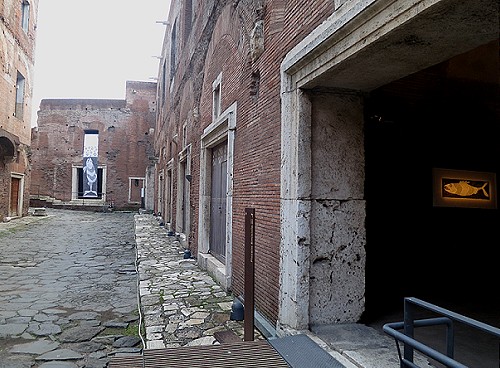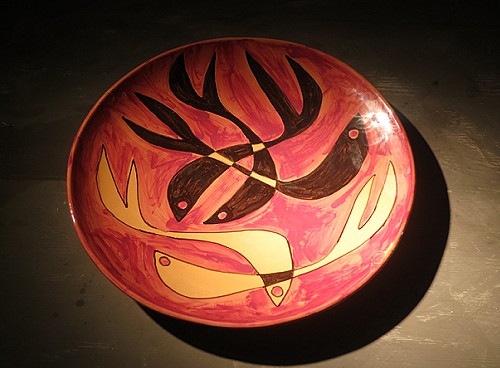 The majestic entrance of the Trajan's Markets is placed at a higher level, because the building is leaning on the Quirinal Hill. Access from the floor of the Imperial Forums was blocked by buildings constructed centuries if not millennia later.
The majestic entrance of the Trajan's Markets is placed at a higher level, because the building is leaning on the Quirinal Hill. Access from the floor of the Imperial Forums was blocked by buildings constructed centuries if not millennia later.
A steep staircase takes us to the hemicycle. With its shabby appearance, it seems at first sight to lead to a dark dungeon.
But at the end you see the light to which the visitor is attracted, even without any other indications.
 The old access to Via Biberatica probably started from here, and it is from here that the visit Mediterraneum starts, even though the stairway is further off, around the corner.
The old access to Via Biberatica probably started from here, and it is from here that the visit Mediterraneum starts, even though the stairway is further off, around the corner.
On the left, unfortunately not accessible for visitors, the tabernae are home to the world's most important collection of Roman amphorae from transport. The stamps of manufacturers, traders and imperial officials in charge of supplies will the day come back to attract an interest in our past. They will allow to reconstruct the dense texture of human relations across the Mediterranean: this is what one of the civilisations that arose and flourished there simply called Mare Nostrum.
 On the right, the Mediterraneum exhibition begins with a theme that is material only apparences: the sea as a source of food and livelihood, including an economy of its own.
On the right, the Mediterraneum exhibition begins with a theme that is material only apparences: the sea as a source of food and livelihood, including an economy of its own.
The tables set up inside the tabernae are periodically filled with food from the sea and from the land, processed exclusively at artisanal scale and offered to visitors.
It is intended to return visitors to an earlier, more primitive, food in a quite material way, and in any case also trigger a cultural awakening that is late in arriving in contemporary society.
 The techniques used by Oreste Baldini for the creation of his art works are varied.
The techniques used by Oreste Baldini for the creation of his art works are varied.
Some are ispired by classical or popular art which developed all around the Mediterranean, others are entirely original.
These polycrome plates seem to make reference to many artifacts handed down to us from Greek civilisation.
 Perhaps, but not consciously.
Perhaps, but not consciously.
The artist has complied with philological care the traditional techniques or innovated without hesitation.
He has created out of his own mind or has drawn from the past for his inspiration.
But his works do not show the memories that would confirm that he had copied some artifact.
 Next to the depiction through painting, sculpture or any other means of expression, of the fish icon and its trajectory - also symbolic - there is the powerful representation of the multitude of fish.
Next to the depiction through painting, sculpture or any other means of expression, of the fish icon and its trajectory - also symbolic - there is the powerful representation of the multitude of fish.
This as well is rendered with the different techniques, ancient or modern, philological or innovative.








